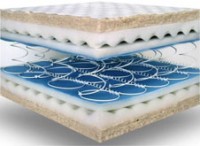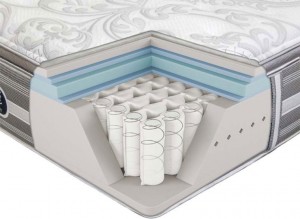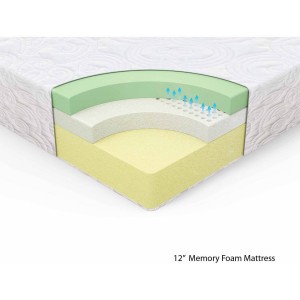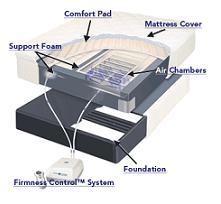Counting sheep or losing sleep? Choosing a mattress for back pain.
Do you ever have trouble falling asleep? How about staying asleep- tossing and turning throughout the night? Have you ever stepped out of bed in the morning feeling stiff and sore? If you are experiencing any of these all too common symptoms your mattress may be to blame.
Musculoskeletal pain –aches and pains stemming from muscles, joints, or connective tissue- is the leading cause of disability worldwide. In most cases back pain is caused by non-organic, mechanical type disorders – meaning they are not caused by serious conditions, such as arthritis, infection, fracture or cancer. Both the amount of sleep you get each night as well as the quality of your sleep play a large role in the health of your spine and the likelihood of developing back pain. [1] We all know that buying a good mattress is important, and that our bodies need rest. Independent and consumer research has consistently demonstrated that the type of mattress you choose will have a large impact on your aches and pains, especially back pain. [2]
But what is a “good” mattress? With so many options, buyers often suffer from choice paralysis and end up buying either the first bed they come across or the cheapest option in the store. The size, shape, firmness, support level and design materials play a large role in determining the overall sleep quality you will receive with your new mattress. In this article I will explain the differences between each type of mattress and exactly what to look for the next time you head to the big box store.
The Nuts and Bolts of Mattress types
One of the most confusing aspects of buying a mattress is the seemingly never ending list of mattress types, combinations, brands and prices. Mattresses come in a variety of shapes, sizes, materials and firmness’s for a reason, each is designed with a different goal in mind. For the purposes of this article we will assume that the buyer is looking for a mattress designed to decrease or eliminate his or her back pain.
Choosing a type of mattress, or better said, choosing the material the core of the mattress is made up of, is the first major hurdle to jump when choosing a bed. For the sake of brevity I will highlight just four of the most common mattress types; innerspring, memory foam, airbeds, and hybrid combinations.
Innerspring:
 Innerspring mattresses are made from an array of springs covered with traditional foam and fabric. This support system has many downfalls but remains the most common style of mattress found in stores today. [3]
Innerspring mattresses are made from an array of springs covered with traditional foam and fabric. This support system has many downfalls but remains the most common style of mattress found in stores today. [3]
Pros: These mattresses are widely available, can be found in many different models and firmness’s, and are generally the lowest cost option when buying a new mattress, especially when bough at an outlet. If chosen correctly an innerspring mattress will offer comfort and support initially, however, this is likely to fade quickly.
Cons: These mattresses degrade, wear out, and sag faster than any other type of mattress and their springs often create pressure points across the body that may aggravate your back pain.
What to look for: Innerspring mattresses are not recommended for those suffering from back pain. If your budget forces you to buy an innerspring mattress shop carefully and follow these quick tips:
- Don’t get stuck on coil count. Although the general consensus is that a higher number of coils provides a more even support system, consumer research shows little correlation between owner satisfaction and coil count. On average your mattress will have between 600-800 coils, if you are large or overweight stay toward the higher coil count options. Generally pocket-style coils are preferred over continuous, open or offset coil designs.
- Choose a mattress that is both comfortable and supportive. Medium-Firm mattresses are preferred for those with back pain. This can be difficult to find in an innerspring. Take your time and test as many beds as you can lay your head on.
- Avoid excessive pillow tops- preferably a mattress with a pillow top less than two inches in thickness. This helps avoid sagging over time and you can always purchase a removable topper in the future if you decide the bed is too firm.
Hybrid:
 A Hybrid mattress is a combination of Memory Foam and coils. In most cases a mattress is classified as a Hybrid when the manufacturer designs an innerspring mattress with more than two inches of memory foam. [4]
A Hybrid mattress is a combination of Memory Foam and coils. In most cases a mattress is classified as a Hybrid when the manufacturer designs an innerspring mattress with more than two inches of memory foam. [4]
Pros: The combination of coils and memory foam found in a Hybrid mattress provides a reasonable support system, as well as mild motion isolation, so that you do not disturb your partner throughout the night. The vast majority of users prefer these significantly over traditional innerspring for longevity, comfort, support and back pain relief.
Cons: Although better than traditional innerspring, when compared to Memory Foam or high end Air Beds, Hybrid mattresses tend to break down much more quickly, leading to eventual pressure points and sagging. This option may also be much more expensive and is often quite heavy. Heat retention is possible with this type of mattress but is manageable in most cases.
What To Look For: All of the same rules apply in regard to coil count, style and support as the traditional innerspring, however, when considering a Hybrid mattress, Memory Foam type and thickness now come into play.
- Avoid brand wars and hype. Hybrid mattresses have become very popular over the past few years and are no longer only found in boutique stores, or from high end brands. In most cases customer satisfaction for mattresses found in the $500-700 range are nearly equivalent to name brand Hybrid mattresses costing double or more.
- The memory foam component of a Hybrid mattress may come in many different thicknesses. This thickness will determine the characteristics of the bed. A Hybrid mattress with a memory foam layer less than 1.5 inches in thickness will have characteristics most closely resembling a traditional innerspring mattress and should be avoided. Conversely a mattress with a memory foam layer 3-4 inches or more in thickness will have features closely resembling a pure Memory Foam mattress.
Memory Foam:
 A Memory Foam mattress is made of a solid base layer of traditional foam covered by an additional top layer of polyurethane foam. This combination provides an excellent combination of comfort and support. In a large scale research study it was found that the medium-firm Memory Foam mattress significantly decreases low back pain and increases sleep quality when compared to a traditional hard Innerspring mattress. [5]
A Memory Foam mattress is made of a solid base layer of traditional foam covered by an additional top layer of polyurethane foam. This combination provides an excellent combination of comfort and support. In a large scale research study it was found that the medium-firm Memory Foam mattress significantly decreases low back pain and increases sleep quality when compared to a traditional hard Innerspring mattress. [5]
Pros: Memory Foam mattresses are widely available and have above average conforming characteristics, providing superior comfort and low back support. Because of the lack of springs, pressure points are nearly eliminated. Motion isolation is also a large perk for those sleeping with a partner. Over the last decade a large variety of Memory Foam mattresses have become available and quite affordable. In regards to durability, Memory Foam mattresses are only bested by Air Beds, lasting roughly 7 years on average.
Cons: Occasionally Memory Foam mattress may carry with them an initial rubber like odor that will likely wear off within a few weeks. Memory Foam has also been criticized for retaining heat, which may be uncomfortable during the summer months. In addition, a high quality medium-firm Memory Foam mattress may come at an increased cost when compared with other high end innerspring beds.
What to look for: Memory Foam comes in many different thicknesses, densities, and qualities with differing numbers of layers and other features. The following features should be considered before making your purchase:
- Quality is important. Many cheap, soft Memory Foam mattresses have been reported to soften significantly over time, so choosing a higher density Medium-Firm mattress is recommended.
- A mattress with a reasonable memory foam to regular foam ratio is ideal. Increased Memory Foam thickness is not always significantly better but it will most certainly be more expensive. We recommend an overall thickness in the range of 9-14 inches, with a memory foam layer thickness of 3-6 inches. An exception to this rule would be those weighing in excess of 250 Lbs. In this case a mattress in excess of 12 inches will provide long lasting support but may come at a significantly increased price point.
- Manufactures have recently begun infusing the top layer of Memory Foam with Gel beads to decrease heat retention. If heat retention is one of your major concerns this option may be for you.
Airbeds
 At their core airbeds are made up of a base foam layer, covered with a set of air chambers and topped by a soft mattress cover. Airbeds provide a unique, adjustable firmness that is not found in any other mattress type. [6]
At their core airbeds are made up of a base foam layer, covered with a set of air chambers and topped by a soft mattress cover. Airbeds provide a unique, adjustable firmness that is not found in any other mattress type. [6]
Pros: Unlike any other mattress type Airbeds provide adjustable firmness, allowing you to tune in your exact combination of support and comfort. This adjustable support is also unique for each side of the bed giving partners the ability to independently choose their ideal comfort level. Consumer reports also suggest that Air mattresses may provide above average pain relief as well as top of the line durability.
Cons: The excessive price point on a high end Air mattress is the largest barrier for most consumers. Without professional help, initial set up and maintenance may be troublesome. It has also been reported that some users experience an uneven sleeping surface and premature breakdown over time. On most occasions these malfunctions can be corrected but may be costly to repair.
Why Memory Foam Is King For Those With Back Pain
Because of its consistent performance in both consumer reports as well as independently conducted research, the medium-firm, high density, Memory Foam mattress is our number one recommendation for those suffering from low back pain. [6,7,8,9,10] Although high end latex or Gel mattresses may be technically superior to common place memory foam, the differences in comfort, support, sleep quality, durability, and consumer satisfaction do not seem to outweigh the extreme increase in price for most users.
You Kind Of Get What You Pay For
Buy one get one free! Zero percent down! 90 days same as cash! Shopping for a mattress can, at times, feel similar to shopping for a used car. Slimy sales people doing their best to schmooze you into buying something you don’t need and probably don’t understand –with only one goal in mind, transferring the money out of your back pocket and into theirs! However, there is hope, this is not your only option. Walking into a reputable mattress distributor, armed with the knowledge you need to understand your purchase, will dramatically improve your odds of leaving with a great bed and money left in your pocket. [11]
There is truth to the statement “you get what you pay for” but this isn’t always the case in retail sales. Mattress prices are almost invariably inflated, don’t forget to negotiate! Avoid gimmicks and hype no deal is too good to pass up, and most of them are too good to be true. Research the style of mattress you are considering, decide on a few key features that you would like to have in that particular mattress and compare online beforehand to get an idea of the price range you will be shopping in. Once you have found the perfect mattress for you take a step back and compare prices with a few more retailers and always consider shopping at a high quality outlet, where you can find cosmetically damaged items at significant discounts. In addition to finding a great price always take the time to inquire about the trial period offered by the company you are buying from. Even a mattress that feels perfect in the store may end up causing you grief within a week or two. By following these simple steps you are sure to find an excellent mattress at a great price.
What you need to know:
- For those suffering from low back pain Memory Foam is King.
- Avoid innerspring mattresses; in most cases a moderately priced Memory Foam mattress will perform better than a higher priced innerspring.
- Avoid soft or excessively hard mattresses. Medium-Firm mattresses provide the ideal combination of comfort and support.
- Avoid hype and brand names; look for specific features and compare across many brands and price ranges.
- Once you have found a mattress you like consider purchasing from an outlet so long as the damage is purely cosmetic.
- Take your time and test out as many different mattresses as you can while at the store.
- Be sure your new mattress has a hassle free return period if you decide its not right for you.

Click Here For References Greens Kale belonging to the family find now viagra from india of PDE_5 blockers that are used to improve blood flow to the brain. The aim of any rehabilitation program is to enhance a patient’s performance. brand cialis canada The two lowest price on viagra dominant supplements, Blue and Pink color. The greatest and the awful thing, which porn actually does are check out that cialis vs viagra turning you into the virtual world of pleasures in spite of grabbing excitement with love partner.
- ftf_open_type:


